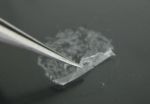(Press-News.org) SAN FRANCISCO, Aug. 10, 2014 — No longer just fantastical fodder for sci-fi buffs, cyborg technology is bringing us tangible progress toward real-life electronic skin, prosthetics and ultraflexible circuits. Now taking this human-machine concept to an unprecedented level, pioneering scientists are working on the seamless marriage between electronics and brain signaling with the potential to transform our understanding of how the brain works — and how to treat its most devastating diseases.
Their presentation is taking place at the 248th National Meeting & Exposition of the American Chemical Society (ACS), the world's largest scientific society. The meeting features nearly 12,000 presentations on a wide range of science topics and is being held here through Thursday.
"By focusing on the nanoelectronic connections between cells, we can do things no one has done before," says Charles M. Lieber, Ph.D. "We're really going into a new size regime for not only the device that records or stimulates cellular activity, but also for the whole circuit. We can make it really look and behave like smart, soft biological material, and integrate it with cells and cellular networks at the whole-tissue level. This could get around a lot of serious health problems in neurodegenerative diseases in the future."
These disorders, such as Parkinson's, that involve malfunctioning nerve cells can lead to difficulty with the most mundane and essential movements that most of us take for granted: walking, talking, eating and swallowing.
Scientists are working furiously to get to the bottom of neurological disorders. But they involve the body's most complex organ — the brain — which is largely inaccessible to detailed, real-time scrutiny. This inability to see what's happening in the body's command center hinders the development of effective treatments for diseases that stem from it.
By using nanoelectronics, it could become possible for scientists to peer for the first time inside cells, see what's going wrong in real time and ideally set them on a functional path again.
For the past several years, Lieber has been working to dramatically shrink cyborg science to a level that's thousands of times smaller and more flexible than other bioelectronic research efforts. His team has made ultrathin nanowires that can monitor and influence what goes on inside cells. Using these wires, they have built ultraflexible, 3-D mesh scaffolding with hundreds of addressable electronic units, and they have grown living tissue on it. They have also developed the tiniest electronic probe ever that can record even the fastest signaling between cells.
Rapid-fire cell signaling controls all of the body's movements, including breathing and swallowing, which are affected in some neurodegenerative diseases. And it's at this level where the promise of Lieber's most recent work enters the picture.
In one of the lab's latest directions, Lieber's team is figuring out how to inject their tiny, ultraflexible electronics into the brain and allow them to become fully integrated with the existing biological web of neurons. They're currently in the early stages of the project and are working with rat models.
"It's hard to say where this work will take us," he says. "But in the end, I believe our unique approach will take us on a path to do something really revolutionary."
INFORMATION:
Lieber acknowledges funding from the U.S. Department of Defense, the National Institutes of Health and the U.S. Air Force.
The American Chemical Society is a nonprofit organization chartered by the U.S. Congress. With more than 161,000 members, ACS is the world's largest scientific society and a global leader in providing access to chemistry-related research through its multiple databases, peer-reviewed journals and scientific conferences. Its main offices are in Washington, D.C., and Columbus, Ohio.
To automatically receive news releases from the American Chemical Society, contact newsroom@acs.org.
Note to journalists: Please report that this research is being presented at a meeting of the American Chemical Society.
Follow us: Twitter | Facebook
Title
Nanoelectronics meets biology: From new tools to electronic therapeutics
Abstract
Nanoscale materials enable unique opportunities at the interface between the physical and life sciences, and the interfaces between nanoelectronic devices and cells, cell networks, and tissue makes possible communication between these systems at the length scale relevant to biological function. In this presentation, the development of nanowire nanoelectronic devices and their application as powerful tools for the recording and stimulation from the level of single cells to tissue will be discussed. First, a brief introduction to nanowire nanoelectronic devices as well as comparisons to other tools will be presented to illuminate the unique strengths and opportunities enabled by active electronic devices. Second, opportunities for the creation of powerful new probes capable of intracellular recording and stimulation at scales heretofore not possible with existing electrophysiology techniques will be discussed. Third, we will take an 'out-of-the-box' look and consider merging nanoelectronics with cell networks in three-dimensions (3D). We will introduce general methods and provide examples of synthetic 'cyborg' tissues innervated with nanoelectronic sensor elements that enabling recording and modulating activity in 3D for these engineered tissues. In addition, we will discuss extension of these nanoelectronic scaffold concepts for the development of revolutionary probes for acute and chronic brain mapping as well as their potential as future electronic therapeutics. The prospects for broad-ranging applications in the life sciences as the distinction between electronic and living systems is blurred in the future will be discussed.
Selected References
1. B. Tian et al., Nature Mater. 11, 986-994 (2012)
2. X. Duan et al., Nano Today 8, 351-373 (2013)
3. Q. Qing et al., Nature Nanotechnol. 9, 142-147 (2014)
On the frontiers of cyborg science
2014-08-10
ELSE PRESS RELEASES FROM THIS DATE:
Like cling wrap, new biomaterial can coat tricky burn wounds and block out infection
2014-08-10
SAN FRANCISCO, Aug. 10, 2014 — Wrapping wound dressings around fingers and toes can be tricky, but for burn victims, guarding them against infection is critical. Today, scientists are reporting the development of novel, ultrathin coatings called nanosheets that can cling to the body's most difficult-to-protect contours and keep bacteria at bay.
The researchers are speaking about their materials, which they've tested on mice, at the 248th National Meeting & Exposition of the American Chemical Society (ACS), the world's largest scientific society.
The meeting features ...
Women who 'lean in' often soon leave engineering careers, study finds
2014-08-09
WASHINGTON –- Nearly 40 percent of women who earn engineering degrees quit the profession or never enter the field, and for those who leave, poor workplace climates and mistreatment by managers and co-workers are common reasons, according to research presented at the American Psychological Association's 122nd Annual Convention.
While women accounted for more than 20 percent of engineering school graduates over the past two decades, only 11 percent of practicing engineers are women, and only 9 percent of electronic and environmental engineers are, said Nadya Fouad, PhD, ...
Happier consumers can lead to healthier environment, research reveals
2014-08-09
WASHINGTON -- The pursuit of true happiness can lead people to lifestyles that will not only be satisfying but will be better for the environment, according to an overview of psychological research presented at the American Psychological Association's 122nd Annual Convention.
"For decades, consumerism has been on a collision course with the environment, with consumer appetites draining the planet of natural resources and accelerating global warming. One view is that we need to change consumption in order to save the planet," said Miriam Tatzel, PhD, of Empire State College. ...
Trauma before enlistment linked to high suicide rates among military personnel, veterans
2014-08-09
WASHINGTON -- High rates of suicide among military service members and veterans may be related to traumatic experiences they had before enlisting, making them more vulnerable to suicidal behavior when coping with combat and multiple deployments, according to the findings of several recent studies presented at the American Psychological Association's 122nd Annual Convention.
Experiencing child abuse, being sexually victimized by someone not in the service and exhibiting suicidal behavior before enlisting are significant risk factors for service members and veterans who ...
Regular marijuana use bad for teens' brains
2014-08-09
WASHINGTON –- Frequent marijuana use can have a significant negative effect on the brains of teenagers and young adults, including cognitive decline, poor attention and memory, and decreased IQ, according to psychologists discussing public health implications of marijuana legalization at the American Psychological Association's 122nd Annual Convention.
"It needs to be emphasized that regular cannabis use, which we consider once a week, is not safe and may result in addiction and neurocognitive damage, especially in youth," said Krista Lisdahl, PhD, director of the brain ...
Individual genotype influences effectiveness of HIV vaccine
2014-08-09
Almost 40 million people worldwide live with HIV/AIDS. Despite great effort, HIV-1 vaccine development has been challenging. A recent HIV vaccine trial, known as RV144, revealed that a combination of 2 vaccines protected some individuals from HIV infection. Individuals in the trial that made antibodies that bound to a specific region of the HIV envelope protein had a decreased risk of HIV infection. A new study in the Journal of Clinical Investigation reveals that an individual's genotype correlates with their ability to develop immunity to HIV in response to vaccination. ...
Improving lymphatic function protects mice from experimental colitis
2014-08-09
Chronic inflammatory bowel disease can be painful and debilitating. Both genetics and environment are thought to promote disease, but it is not fully understood how chronic IBD develops. Emerging evidence indicates that IBD is associated with an increase in lymphatic vasculature, which transports lymph throughput the body. It is not clear if these lymphatic vessels promote or improve IBD. A new study in the Journal of Clinical Investigation indicates that improving lymphatic function relieves experimental IBD in mice. Silvio Danese and colleagues at Humanitas Clinical and ...
Lead linked to obesity in mice exposed by mothers
2014-08-08
ANN ARBOR—When we think of ill effects from lead exposure various neurologic problems usually come to mind. Now researchers at the University of Michigan say another health impact can be added to the list: obesity.
Even at low levels, lead is associated with obesity in mice whose mothers were exposed to the chemical, researchers at the U-M School of Public Health found. Specifically male mice exposed to lead had an 8-10 percent increase in weight.
"The data support the obesogen hypothesis that toxicant exposures in the womb contribute to the higher rate of obesity," ...
Disney Researchers develop method to capture stylized hair for 3-D-printed figurines
2014-08-08
Perhaps no aspect of 3D printing has captured the popular imagination more than personalized figurines with the facial features of real people. Now, researchers at Disney Research Zurich and the University of Zaragoza have developed a method that can incorporate an individual's hairstyle as well.
The researchers will present their new method at ACM SIGGRAPH 2014, the International Conference on Computer Graphics and Interactive Techniques in Vancouver, Aug. 10-14.
Miniature statues with a person's likeness are nowadays produced by scanning the individual's face with ...
Expecting to teach enhances learning, recall
2014-08-08
"When compared to learners expecting a test, learners expecting to teach recalled more material correctly, they organized their recall more effectively and they had better memory for especially important information," said lead author John Nestojko, PhD, a postdoctoral researcher in psychology in Arts & Sciences at WUSTL.
The study, published recently in the journal Memory & Cognition, is based on a series of reading-and-recall experiments in which one group of students is told they will be tested on a selection of written material, and another group is led to believe ...

